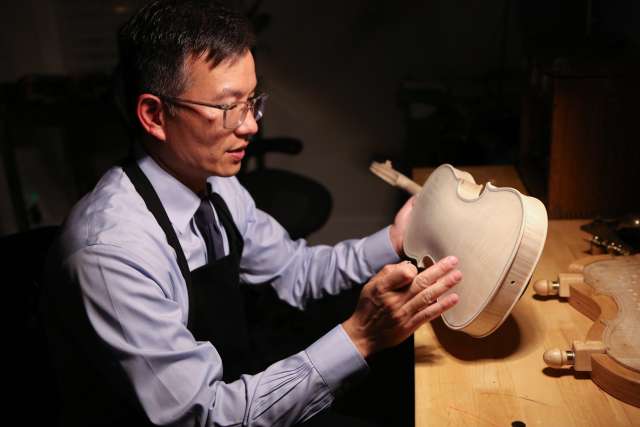The entrance to Angeles Violin Shop isn’t so much a door as it is a portal. It hides in plain sight between a dry cleaner and a minimart in a West L.A. strip mall. Gain entry, and the grit of Pico Boulevard falls away. It’s quiet inside, and gently lit. Workbenches are stacked high with a crazy quilt of tools and raw materials. Stringed instruments at all stages of construction scent the air with sweet notes of cut wood and the sting of glue and varnish. It’s in this workshop that a neurosurgeon from UCLA gets to shed his identity as Dr. Lu. To the musicians and craftsmen who gather here, he’s just plain Daniel, a skilled maker of fine violins.
“There is a freedom for me in violin making that I find liberating,” Daniel Lu, MD, PhD, says of his transition from physician to luthier. “In my work as a surgeon, there are consequences for errors that are potentially severe. Making a violin is a way to hone my skills and not worry about the stakes because no one gets hurt.”
Today, Dr. Lu is at the shop to finalize the gift of one of his hand-crafted violins to a graduate student at UCLA’s Herb Alpert School of Music. It’s the first of many such donations he hopes to make. The form of this specific instrument is inspired by a storied violin made in 1735 known as the “Plowden.” It was crafted by Giuseppe Guarneri, an Italian luthier, whose surviving instruments are as sought after as those of Antonio Stradivari. Unlike many violins these days, which are mass produced, Dr. Lu’s are all bench-made. It means that, through an exacting process with roots in the Renaissance, he takes slabs of spruce, maple and ebony and, over the course of months, coaxes a violin into existence.
Many hobbyists take up violin making, but few of those instruments ever get much serious play. Building such an instrument is a notoriously exacting craft that treads a fine line between art, science and alchemy. Each stage of the process — making the templates, creating the mold, measuring, cutting and incrementally shaping — demands accuracy down to the millimeter. And still, once an instrument is fitted and glued, varnished and polished, each step perfectly rendered, its “voice” remains a mystery until the first notes are played.
“Two different violin makers can start with exactly the same form, use the same wood and follow the same steps, and yet each instrument will come out with its own distinctive sound,” Dr. Lu says. His copy of the Plowden is a beautiful instrument, feather-light, with sinuous curves and a dark, glowing finish. With its complex and powerful voice, it’s a violin that can launch a musician’s career.
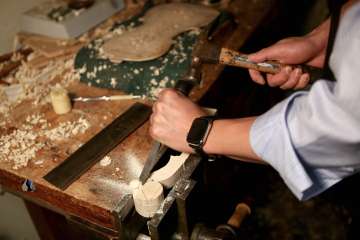
“That Daniel’s violins are on a par with a fulltime maker’s is unusual, if not unique,” says Phillip Levy. An acclaimed violinist with an international reputation — none other than Yehudi Menuhin called him “a most excellent violinist!” — Levy gives Dr. Lu the occasional violin lesson. More often these days, he visits Dr. Lu’s home to play the newly made violins. This allows both men to assess the instruments — and their maker’s progress in his adopted craft. “The level I play at, you can pick up an instrument and know right away if it’s of interest, if it’s worthy, which Daniel’s are,” Levy says. “He takes everything very seriously, precision down to the micron, everything done perfectly, and that’s unique.”
It is the care with which Dr. Lu crafts his instruments that makes them desirable for a musician the caliber of Roberto Cani, concertmaster of the LA Opera orchestra. Among the three violins Cani owns are two built in Cremona, Italy, in the 18th century and one by Dr. Lu. “I’m very impressed by the violins he makes — he’s very talented,” Cani says. “I make violins myself, but not like his.” Cani has played Dr. Lu’s violin during rehearsals, as well as in performance. “His violins are very precise, and they sound quite good,” Cani says. “Modern violins can be quiet; his fill the room.”
Deep curiosity about how things work
The shift from playing violins to making them came naturally to Dr. Lu. “I’ve always wanted to build things, always liked to tinker around and figure out how and why something works,” he says. “Building a violin is like taking something — in this case, music — back to its elements, reverse-engineering it, in a way, and that’s always been fascinating to me.”
In addition to his “day job” as a surgeon, Dr. Lu is a professor of neurosurgery and the principal investigator of UCLA’s Neuroplasticity and Repair Laboratory. He also serves as vice chair of research in the Department of Neurosurgery. He and his team are conducting National Institutes of Health-funded research into the mysteries of the spinal cord and ways to improve function after injury. “We’ve generally sorted out how the kidneys work, how the heart functions, how the GI tract works, how the muscles work, but the brain and the spinal cord — there are trillions of connections,” Dr. Lu says. “It’s as large as a universe, and we still haven’t figured out how it’s all put together.”
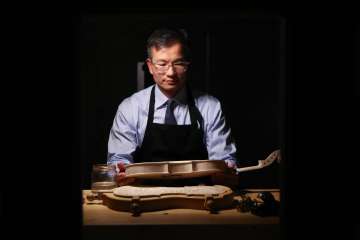
Dr. Lu is particularly interested in the concept of automaticity, or muscle memory, and the body’s ability to create alternative neural pathways. With a more-complete understanding of these mechanisms, and utilizing cutting-edge neural-stimulator implants, it could be possible to help someone with a paralyzing spinal-cord injury to regain function, he says.
It’s all part of a career path that echoes Dr. Lu’s earliest interests. “When I was a kid, I used to take things apart — dismantle a radio, the telephone, take apart some toys. Unfortunately, I wasn’t always quite as successful at putting them back together, and there was often a spare part or two left over,” he says, with a laugh. “It’s that same curiosity and that mystery that eventually drew me to neuroscience, and it still draws me to other creative pursuits.”
Among the earliest of those pursuits was music. Dr. Lu took his first violin lesson at the age of 12, several years after he moved with his family from Taiwan to Los Angeles. “I started playing the violin a little late,” he says. “We emigrated to the U.S. when I was 10, and at that time I didn’t speak any English and was working to learn the language. So, I didn’t start playing until around middle school.”
The violin is a demanding instrument. With four strings, no frets and an infinity of options for how to use the bow, the learning curve can be steep. But the mix of precision, daring and intuition the instrument requires appealed to the young teen, and violin became a passion. He continued his music studies throughout high school and played in the university orchestra as an undergrad at Dartmouth College. While earning his PhD and MD degrees from UC San Diego, Dr. Lu performed with a small chamber music ensemble. But then came the intensive years of a neurosurgery residency in San Francisco, during which his violin rarely left its case. It wasn’t until 12 years ago, when he joined the Department of Neurosurgery at UCLA, that Dr. Lu found the breathing room to make music again. He unpacked his instruments, picked up a bow, and then serendipity came into play.
“It was in 2012, when I had some bows and violins that I needed to have worked on,” Dr. Lu recalls. He asked fellow musicians to recommend a good luthier, and they directed him to Angeles Violin Shop. The owner, Jeff Muller, is a second-generation violin maker renowned for his skill and knowledge. He began learning his craft as a boy, helping out after school in his father’s Sacramento violin shop. As a young man, Muller took his place alongside his father as a full-fledged luthier. His small Los Angeles shop, an exuberant study in organized chaos, leads Dr. Lu to refer to him with affection as “some kind of mad genius.” And, as Dr. Lu quickly learned, Muller is also a generous teacher.
“Daniel came in for a bow re-hair, and right away he was very interested in what I do here. He asked if he could learn how, and I said sure,” Muller says of their initial meeting. “But making bows didn’t interest him as much as making a violin. He came in with a picture of an instrument he liked and said, ‘OK, I want to make a copy of this.’ I said sure, and now here we are.”
Those first few months held surprises for them both. It wasn’t Dr. Lu’s transition from customer to student that proved remarkable. In the 25 years that Muller has owned his shop, more than a few of his clients have waded into violin making as a hobby. What stood out with Dr. Lu was how quickly he learned, and how adept he became.
“You get people who come in and follow the steps, cobble something together, and the instruments they made just don’t sound,” Muller says, referring to the crucial ability of a violin to project its voice. “But Daniel’s violins are like cannons. He’s got very good hands. He’s very meticulous. And he listens quite well. All of that makes working with him easy. It’s very unusual to have someone come in at the hobby level and make instruments that are this good.”
Violins on par with the very best
For Dr. Lu, there was the unexpected surprise of finding a new setting for his skills. “I do surgery, and we’re talking about the need for sub-millimeter precision, which is an existing skill set that I can apply to the violin,” he says. “But in violin making, there’s a lot of give. Even if you make an error, there are ways to work around it to give each instrument its distinct personality.”
The process begins in Angeles Violin’s workshop, where Muller uses an industrial-size band saw to cut the wood slabs. “No, I don’t let Daniel do that part — his hands are just too valuable,” Muller says. But the rest of the building, 300 to 400 hours per violin, is done by Dr. Lu alone.
Working at night, which is his only free time, he trades the instrument tray of the OR for a tool chest. It’s stocked with the chisels, knives, finger planes and rasps that he uses to cut, scoop and shave the delicate parts of a violin into existence. As the hours pass, curls of spruce pile up around him. Some are so thin they seem transparent. Often, it’s midnight before he interrupts his flow and finally heads to bed. “I’ve found a lot of similarities between surgery and this kind of work,” Dr. Lu says. “When I say to someone that I’ve been in surgery for eight hours, they’ll think that’s a long time, but it goes by in what feels like a second. It’s like an out-of-body experience when you’re concentrating, and things go right.”
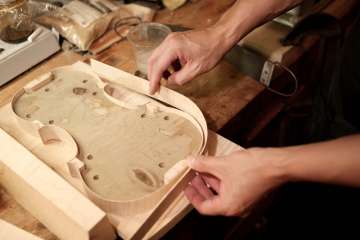
The impetus for his first violin, which has since been followed by 11 others, was Dr. Lu’s 7-year-old son, Sebastian. “I want him to learn to play, but like his mother, he plays the piano,” Dr. Lu says. “We’re hoping that his sister, Emmie, will take it up, but right now, she’s only 3. So, we’ll have to wait a few years and see.”
Until that time, he continues to build a violin collection to share with promising music students at UCLA. The purchase price of a violin of such quality can range from $15,000 to more than $30,000. It’s a prohibitive sum for a student. And while it makes sense that someone like Dr. Lu would donate an instrument to the university’s violin program, the fact that he builds them himself makes the gifts all the more meaningful.
Arutyun Piloyan was both grateful and relieved to learn he would receive the gift of a violin. A graduate of the Tchaikovsky Moscow Conservatory, he’s an exceptional violinist on the cusp of establishing a professional career. Soon after arriving at UCLA to continue his studies, though, his teachers told him he would need a better instrument in order to progress. And while the news of the donated instrument was a godsend, the details of its origin struck Piloyan as less than promising. “When my professor told me that Dr. Lu is a neurosurgeon, and that he had built this violin himself, I thought it was a joke,” he says. “I know people who make violins as a hobby, and these are not instruments that you are going to want to play.”
But his teacher was serious, and Piloyan was intrigued. He tried out several of Dr. Lu’s instruments and was immediately impressed by their quality. And the moment he played the Plowden copy, he knew he had found his new violin. “I picked it up, and it sounded like a great violin, like an old violin, warm, with a bit of a sweet sound — but not too sweet — which I love,” Piloyan says. “I can play anything on this violin. I thought maybe it’s that way just for me, but my teacher played it as well, and he found the same thing.” In fact, Piloyan’s teacher compared Dr. Lu’s violin to ones often heard in a concert hall — the kind of Old World instruments that are considered to be the gold standard for violins and can cost upward of $150,000 — and found the sound of his Plowden to be superior.
Piloyan recently played Dr. Lu’s violin in an audition and won the position of concertmaster with the UCLA Philharmonia, the music school’s flagship orchestra. A few weeks later, when he performed in Schoenberg Hall, his new violin continued to exceed his expectations. Now, meeting with Dr. Lu at Angeles Violin Shop for a final consultation, Piloyan was jubilant. “It’s fantastic, this violin, beautiful, and so easy to play. And the sound — every day the sound gets better,” he says. “It’s so generous of Dr. Lu to help me like this because I just arrived here, and music is everything for me.”
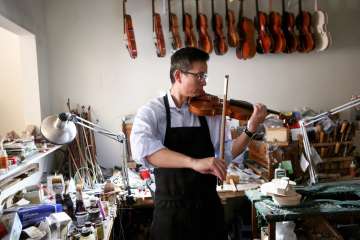
Piloyan played for a few moments, a bit of the buoyant brightness of Mozart’s Violin Concerto No.4, then a peek into the Sibelius Violin Concerto, dark and wistful. Dr. Lu and Muller exchanged glances as the sound spilled into the room and nodded, both of them satisfied. A new phase of Dr. Lu’s journey as a luthier had begun.
“You don’t just build a violin by yourself. There’s a lineage to it, and I’m honored to be a part of that,” Dr. Lu says. “It’s the same in neurosurgery, where the person you train with imprints their principles and their ideals onto you, and then you carry that torch.”
But the real satisfaction of learning the art and craft of a luthier is when an instrument reaches a musician’s hands. “The greatest amount of joy comes from listening to someone play one of my violins,” Dr. Lu says. “Seeing your violin out in the world, bringing music and happiness to other people — it’s indescribable, really. It’s above anything I felt as a performer and is the true fulfillment of building a violin.”
Veronique de Turenne is the author of this article, originally published in the Winter 2022 issue of U Magazine.
